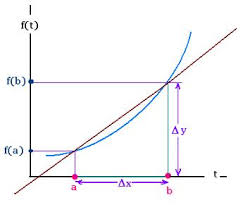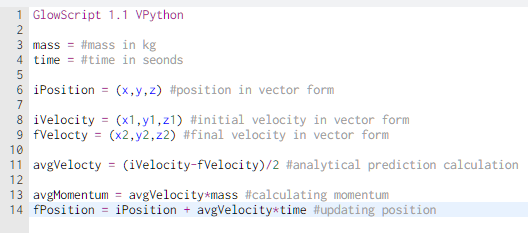Analytical Prediction
By Hayden McLeod (hmcleod6)
CLAIMED FOR IMPROVEMENT BY JOHN BELL, SPRING 2016
The Main Idea
Analytical prediction uses a mathematical function that can describe the position or velocity of a system at any given time. In contrast to iterative prediction, this means that there is no need to make multiple calculations at small steps in order to find a solution. However, due to the method of derivation of the velocity, the analytical method is only accurate to a high degree when the force applied to the system is constant. Due to this limitation, the iterative prediction method is much more generally applicable.
A Mathematical Model
Unlike the iterative prediction method which is derived directly from the momentum principle, the formula for analytical prediction is based of the formula for the arithmetic mean.

Here, X bar is the arithmetic mean, sigma f x is the sum of all the values, and sigma f is the total number of terms. Since we only need two values of velocity to calculate the average velocity, the formula, for this purpose, can be simplified.

A Computational Model
Below is a visualization of the analytical prediction of the average velocity. As you can see, it takes two points, (a, f(a)) and (b, f(b)), and finds the average between the two points. Also depicted in the image is the incapability to model non-linear curves by comparing the average slope (velocity) compared to the actual slope (velocity).

In addition, an example of using this method in GlowScript can be seen below.

Not only does this code show how to use the analytical prediction method using python/GlowScript, it also shows how you can use that average velocity to calculate the momentum and update the position. These are the typical calculations associated with prediction methods.
Examples
Example 1
A train is observed to be traveling at a speed of 24 m/s before it enters a city. While in the city, it is observed going 13 m/s. What is the average velocity of the train?
24 m/s + 13 m/s = 37 m/s
37/2 = 18.5
The average velocity of the train based on the analytical prediction method was 18.5 m/s.
Example 2
A car is traveling at a speed of (18, -2, 0) m/s. Later, the car is observed to be going (22, 6, 0) m/s. If the car started at the location (40, 170, 0) what is it's position after 30 seconds?
First, you have to find the average velocity:
(18, -2, 0) + (22, 6, 0) = (40, 4, 0)
(40, 4, 0) /2 = (20, 2, 0)
so the average velocity is (20, 2, 0) m/s
Second, calculate the change in position:
Change in position = average velocity x time
(20, 2, 0) * 30 = (600, 60, 0)
So the change in position is (600, 60, 0) m
Finally, update the position:
final position = initial position + change in position
(40, 170, 0) + (600, 60, 0) = (640, 230, 0)
The final position is (640, 230, 0) m
Connectedness
- How is this topic connected to something that you are interested in?
Since this topic is based on such a fundamental mathematical principle, my interest in it lies in how wide spread this principle can be used not only in physics but in many other applications, fields, and scenarios.
- How is it connected to your major?
As stated in the previous connection, this basic principle has ties in just about every major with any connection to math including business, sciences, and engineering. Specifically, methods like this are often used to try and model basic relationships of properties in material science.
- Is there an interesting industrial application?
In industry, methods like this, or methods very similar, are used every day to help process and analyze data in a very basic and quick way.
History
Historically, it is well known that basic algebra was discovered and implemented well before calculus, especially based on the fact that algebra was used as a basis to develop calculus. For this reason, it can be assumed that the analytical approach to physics problems related to velocity, or any other changing value, was used long before the iterative method. There is no information on who would have used this approach or when this approach was first used in a physics application.
See also
Vectors, Momentum Principle, Iterative Prediction
Further reading
There are several easily accessible resources with more information on analytical prediction methods and arithmetic means
External links
References
http://www.platinumgmat.com/gmat_study_guide/statistics_mean (information) http://ncalculators.com/statistics/group-arithmetic-mean.htm (image) https://quizlet.com/24263897/mcat-physics-formulas-flash-cards/ (image) http://mathinsight.org/approximating_nonlinear_function_by_linear (image)